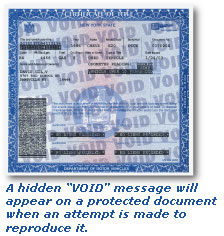Brand Security & Product Authentication Special Report, Part 2
- Published: June 30, 2006, By Dave Wicker, Document Security Systems
Part 1 | Part 2 | Part 3 | Part 4
Tamper Proof
The problem of counterfeit goods usually starts with packaging. Often a label is altered or a document that accompanies a product is falsified. Would-be counterfeiters use desktop graphic design stations as well as printers, scanners, and copiers to produce false materials. Unsuspecting consumers accept the fraudulent products, and the manufacturer is duped out of millions of dollars and faced with potential liability surrounding the false product. The formula is that simple.
Because of the increased demand for a solution to this costly crime, technology that thwarts counterfeiters and offers brand protection is being used by leading world financial institutions and large manufacturers alike to protect vital documents, negotiable instruments, and brand packaging.
Through covert and overt forensic verification technology, consumers, distributors, wholesalers, retailers, manufacturers, and law enforcement have the chance to verify whether a document, label, package, or product is genuine or fraudulent.
Several types of anti-counterfeit technology are available. Those most useful for protecting labels and packaging are optically based security solutions, anti-color copier reproduction technology, and “hidden word” technology.
Optically Based Technology
Optically based security solutions provide overt security solutions for the outward protection of printed materials. The technology is applied to a label, document, or package printing process using ink and is extremely difficult to replicate. Using a proprietary, handheld plastic verifier lens, the technology indicates whether a document is genuine. When the verifier lens is held over a document or image, a multi-color hidden word, symbol, or image is displayed. In addition, if the document is copied, the prism image itself is not duplicated.
Color Copiers and Photo Processors
Patented block-out technology also provides an effective counterfeiting deterrent, preventing color copiers and photo processors from replicating any image.
When a would-be counterfeiter attempts to color-copy a protected label or other image imprinted with block-out technology, the result is a solid black image, a distorted copy, or no copy at all. Ideal for labels, packaging, and Homeland Security, this technology is capable of being integrated into, and protecting, highly sensitive government documents such as ID cards or anything that needs to be protected from unauthorized reproduction on color copiers.

Hidden Word Technology
In hidden word technology, void pantographs are hidden word messages that appear when an attempt is made to reproduce a protected document. They have been the foundation for protecting financial instruments, sensitive documents, and packaging against counterfeiting, but many of the pantograph technologies on the market today were designed in the 1970s for photocopiers, not for today’s digital scanning copiers or desktop scanners; more recent products give limited success with digital imaging devices.
Today hidden message technology is available that stands up to the most sophisticated digital scanners and copiers such as the Xerox DocuTech and the Canon Image Runners. It can be printed in virtually any color, including red or reflex blue. When copied or verified, crisp, dark, indisputable warnings such as “void” or a custom image will appear.
The losses that counterfeiting can cause—not all of which are financial—can be tragic. For example, the pharmaceutical industry is experiencing great pain from counterfeit drug packages and labels, which are causing illness, and in some cases, death. That industry is looking for security solutions that will work at a variety of levels, both overt (to additionally reassure the potential customer) and covert.
SUPPLIER INFO:
Document Security Systems—PFFC-ASAP 314. documentsecurity.com
Dave Wicker is VP, operations and technology, of Document Security Systems, Rochester, NY. He is responsible for product awareness and developing business solutions for clients’ documents and brand packaging. From 1991 to 1998, as a member of the Wicker Group, he was involved in security printing licensing and implementation of newly patented technology. In October 1995, he was awarded a US patent for perforations designed to thwart fraud. Contact him at 585/325-3610.
Part 1 | Part 2 | Part 3 | Part 4











